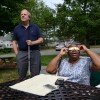The number of people who took to the streets for Women’s March on Washington, D.C. and its sister marches across the country and the globe far exceeded the expectations of local and national organizers.
In a sea of pink cat-eared “pussyhats” nearly five million people from all seven continents carried placards that read “Make America Sane Again,” “Men of Quality do not FEAR Equality,” “Viva La Vulva,” and "I am no longer accepting the things I cannot change; I am changing the things I cannot accept,” to highlight a few, showing a counter-inauguration to the nation's new president's vision for the country and world.
What was also on display at the marches was a resurgence of feminism that was multi-generational, highlighting an amalgam of issues including abortion, equal pay, immigration rights, environmental protection, transgender rights, and police brutality, to name a few. It might possibly be the beginnings of a fourth wave called “intersectional feminism,” embraced by both women and men.
While previous women’s marches and waves of feminism had primarily been intentionally exclusive women's country clubs that spoke to Betty Friedan's feminine mystique of upper-crust “pumps and pearls”-wearing white women, this march was intentional in bringing various women and their voices and concerns to the organizing table.
Tamika Mallory, one of the D.C. organizers and who is African-American, told Joy Reid of MSNBC the morning of the D.C march that by devising an intersectional policy platform centering the voices of women of color “you set the agenda or you become an agenda item.”
However, with women of color's voices and concerns as an organizing principle which asked white women “to listen more and talk less” and check their white privilege at the proverbial door at the marches, there was neither a consensus nor solidarity among the white sisterhood majority with that objective.
Women in the World writer Emma-Kate Symons asked in an op-ed piece last week, “Can’t we rise above the sniping about ‘privilege,’ ‘white feminism,’ ‘intersectionality,’ and hierarchies of grievance in the face of Trump and the dangers he poses to the American and international liberal world order and women everywhere?"
Mixed feelings erupted among women of color about attending the D.C. and sister marches as we feared that, once again, a white sisterhood would exploit not only our suffering to legitimate their cause, but also our black and brown faces for photo-op moments where we are seen and not heard or, if heard, not taken seriously.
In Jamilah Lemieux’s op-ed “Why I’m Skipping The Women’s March on Washington," for Colorlines, she stated:
"Much of the post-election news cycle was dominated by White folks wringing their hands: How could this happen? Why did it happen? There was lots of weeping and wailing from women who could get the answers to those questions by simply asking their relatives, friends and partners who put Trump in power…And just what would this “million” women be coming together to march about—their mothers, sisters, homegirls and friends who elected Trump in the first place?”
The nagging question many women of color who did and didn’t attend marches want to know is where was this same energy and white sisterhood going to the polls in November? 53 percent of white women voters cast their ballots for Donald Trump, whereas 94 percent of black women, in particular, cast theirs for Hillary Clinton.
Many women of color did, indeed, attend the marches. Angela Peoples went to the march in D.C. wearing a Trump-like red hat that read “Stop Killing Black People” and carried a sign that read “White Women Voted for Trump," and her photograph has since gone viral.
I think this photo is going viral.. can y'all credit me and @MsPeoples if you get a chance!? #bychubbz #WomensMarch #WomensMarchOnWashington pic.twitter.com/tTa901RCnd— W.E.B Da Boss (@afroCHuBBZ) January 21, 2017
However, it must be noted that there is a difference between marching for everyone’s civil rights versus marching because white women now recognize a diminishment of their white privilege.
There were, indeed, white women who voted for Trump at the D.C. march. Many of these women shared with me that they voted for him for economic reasons. And while many of them didn’t mind Trump cutting Obamacare, they were either aware or upset to learn that the Affordable Care Act, which they now receive but will soon be repealed, was the official name for Obamacare.
The Boston March turned out a record number of nearly 200,000, but a white female friend of mine troubled by the complexion of the march sent me an email stating the following:
"Maybe you can answer this question for me. There was a lack of Blacks and People of Color at "The March"…WHY? What can be done to motivate more to “come out"? Am I naive?”
While I can’t speak for all black people I can say that a lot of African-American men and women didn’t show up for sister marches in predominately white towns and cities, in spite of the marches’ internecine tensions, where the practice of “Stop and Frisk” is overwhelmingly acted upon people of color.
However, it’s these sort of questions that help forge change in building a stronger sisterhood and a safer world.




